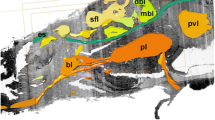Summary
The existence of structural asymmetries has been quantitatively demonstrated in the crayfish compound eye. Variations in the size of the rhabdomes and corneal facets, as well as the size and extent of the accessory reflecting pigment cells, have been found. It was determined that the mean rhabdome diameter within a 70° arc in the dorsal quadrant of the retina is 11–19% smaller than the mean rhabdome diameter in the remaining areas of the eye. Also, the extent of the accessory reflecting pigment cells is diminished over an area corresponding generally to the dorsal region of smaller rhabdomes. Corneal facet size and shape vary over the surface of the cornea, with smaller facets occurring in the dorsal region. Both the mean rhabdome diameter and the mean corneal facet area for whole eyes increases linearly in animals ranging in size from 3.9–12 cm. The estimated number of corneal facets, and therefore the number of rhabdomes, increases from an average of 4700 in the 3–6.9 cm size range to about 6000 in 7–12 cm animals. These data indicate that structural asymmetries and various size-related parameters exist in the crayfish eye and should be considered in any quantitative analysis of this structure.
Similar content being viewed by others
References
Barlow HB (1952) The size of ommatidia in apposition eyes. J Exp Biol 29:667–674
Barrós-Pita JC, Maldonado H (1970) A fovea in the praying mantis eye II. Some morphological characteristics. Z Vergl Physiologie 67:79–92
Bernhards H (1916) Der Bau des Komplexauges von Astacus fluvia-tilis (Potamobius astacus L.) Ein Beitrag zur Morphologie der Decapoden. Z Wiss Zool 116:649–707
Bernstein S, Finn C (1971) Ant compound eye: Size-related ommatidium differences within a single wood ant nest. Experientia 27:708–710
Braitenberg V (1967) Patterns of projection in the visual system of the fly I. Retina-lamina projections. Exp Brain Res 3:271–298
Hafner GS, Tokarski T, Hammond-Soltis G (1982) Development of the crayfish retina: a light and electron microscopic study. J Morphol 173:101–118
Horridge GA (1977) The compound eye of insects. Sci Am 237:108–120
Horridge GA, Duelli P (1979) Anatomy of the regional differences in the eye of the mantis Ciulfina. J Exp Biol 80:165–190
Karnovsky MJ (1965) A formaldehyde-glutaraldehyde fixative of high osmolality for use in electron microscopy. J Cell Biol 27:137A-138A
Land MF (1978) Animal eyes with mirror optics. Sci Am 239:126–134
Land MF (1981) Optical mechanisms in the higher crustacea with a comment on their evolutionary origins. In: Laverack MS, Casens DJ (eds) Sense organs. Blochie and Son, Ltd, Glasgow London, pp 31–48
Lapin L (1975) Statistics: Meaning and method. Harcourt Brace Jovanovich, New York
Mazokhin-Porshnyakov GA (1969) Insect vision. Plenum, New York, pp 1–26
Mazokhin-Porshnyakov GA (1975) Investigations on the vision of ants. In: Horridge GA (ed) the compound eye and vision of insects. Clarendon, Oxford, pp 114–115
Menzel R (1972) The fine structure of the compound eye of Formica polyctena — functional morphology of a hymenopteran eye. In: Wehner R (ed) Information processing in the visual systems of arthropods. Springer, Berlin New York, pp 37–47
Parker GH (1895) The retina and optic ganglia in decapods, especially in Astacus. Mitt Zool Stat Neapel 12:1–73
Sherk TE (1978a) Development of the compound eyes of dragonflies (Odonata) II. Development of the larval compound eyes. J Exp Zool 203:47–60
Sherk TE (1978b) Development of the compound eyes of dragonflies (Odonata) III. Adult compound eyes. J Exp Zool 203:61–80
Waterman TH (1954) Relative growth and the compound eye in Xiphosura. J Morphol 95:125–158
Waterman TH (1961) The physiology of Crustacea Vol II. Sense organs, integration, and behavior. Academic Press, New York London, Chp. 1
Williams DS (1982) Photoreceptor membrane shedding and assembly can be initiated locally within an insect retina. Science 218:898–900
Woodcock AER, Goldsmith TH (1970) Spectral responses of sustaining fibers in the optic tracts of crayfish (Procambarus). Z Vergl Physiologie 69:117–133
Woodcock AER, Goldsmith TH (1973) Differential wavelength sensitivity in the receptive fields of sustaining fibers in the optic tract of the crayfish, Procambarus. J Comp Physiol 87:247–257
Author information
Authors and Affiliations
Additional information
Supported by a grant from the National Science Foundation (BNS 80-04587)
Rights and permissions
About this article
Cite this article
Tokarski, T.R., Hafner, G.S. Regional morphological variations within the crayfish eye. Cell Tissue Res. 235, 387–392 (1984). https://doi.org/10.1007/BF00217864
Accepted:
Issue Date:
DOI: https://doi.org/10.1007/BF00217864




